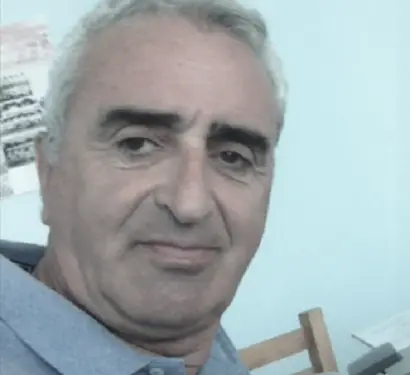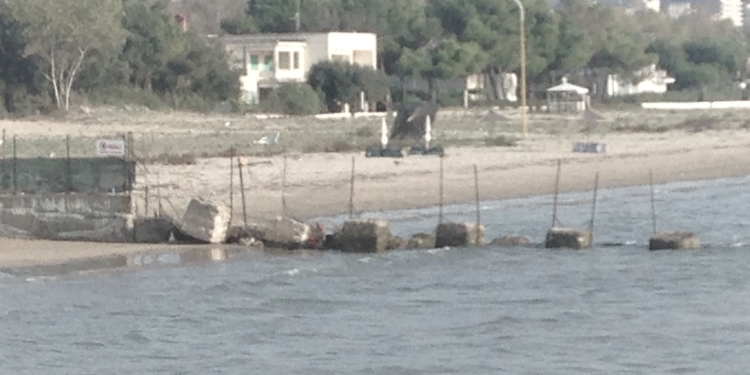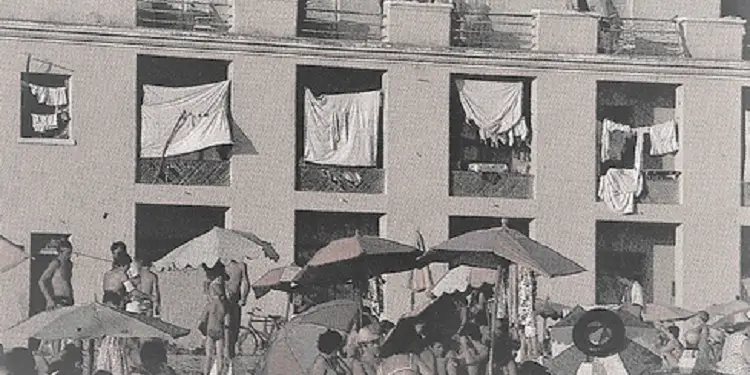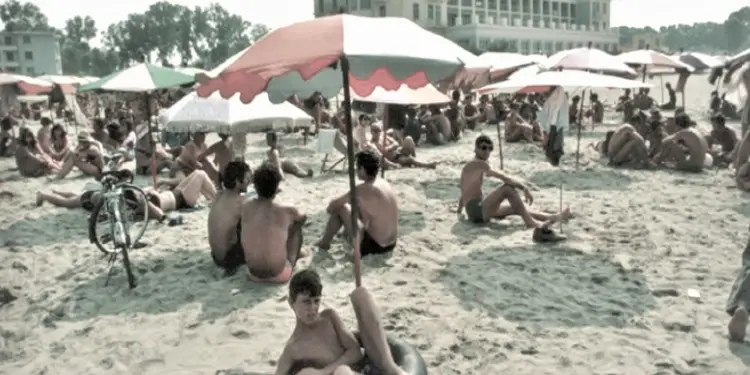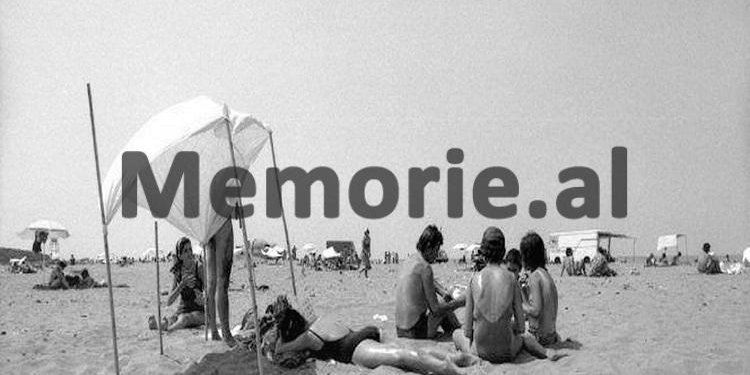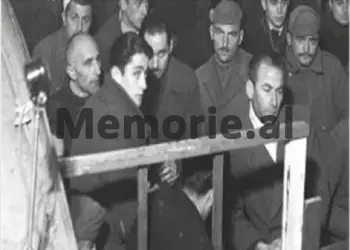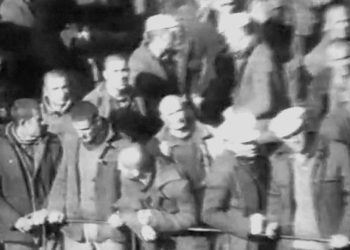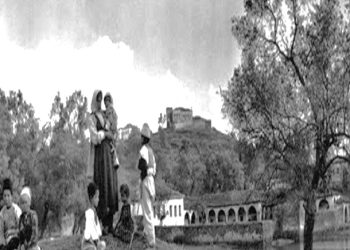From Uvil Zajmi
Memorie.al / What were the favorite beaches, and how did Albanians spend their vacations before and after the 50s, especially those who preferred the sea? Durrës, the most important one, in the three months of summer, frequented by the aristocracy, the wealthy, but also by King Zog himself. Then the period of the 1960s-’70s-’80s were special for Albanians, individuals or families who liked the sea. In those beginnings, the beaches were few and Durrës, Vlora, Saranda were the most important ones. Shengjini started to be preferred later, as well as Divjaka, while Dhërmiu, or the Ionian coast, although it was liked, was limited by the distant, difficult journey and the limited possibility for systematization.
So, Durrës beach was the epicenter, (much less that of Golem and Currila), when the people of Durrës as well as the capital flocked on weekends. Unlike the family stay, which was planned for two weeks, with permits and cabins that were given by the work center or the company, but also with camp leaflets that were distributed by the Professional Associations, mainly for distinguished employees? But also from the Youth Organizations there were camp leaflets for young revolutionaries. In the 80s, there were also tent camps for students located at the “Railway”, across the street. On the beach, there were also villas built by individuals or families during the Kingdom of Zogu, but seized by the communist system and given for use during the summer months to cadres or privileged families.
Of course compared to the wooden cabins, they were very comfortable. Like in the cabins or villas, the family members cooked by themselves and it seemed surprising when in the morning, people or family members came out of the cabins in large numbers, which showed that many people had slept in that cabin, with small spaces. This intense, inevitable Saturday to Sunday. A story, how nostalgic experienced by generations, stretching from “Teuta” to “Apolonia”, “Railway” to “Illyria”, with “Breshkë”, where the stories of the most famous Albanian loves were born.
From the summer train, rental boats, matches, famous tours, fashion, summer cinema, unforgettable daily changing rooms, umbrellas, hand-held radios, Hotel “Adriatiku” with foreign tourists, orchestras, queues for drinking water , Villa “Lule” (by the famous architect Kristo Sotiri) and ‘The Block’, the forbidden area for everyone. A past time, passions without return, which brings my generation back to the well-known song of Italian music, “Come passa il tempo” – sung by Camaleonti, Dik Dik and M. Vandeli, also from the “70s” .
Durrës beach, the beginnings…!
At the beginning of the 20th century, the beach area was agricultural land, even the Durrës-Kavajë road, the Ura e Dajlani – Plepa section, was cobbled and served as a dividing line between the beach part and the agricultural land. Seeing the quality of the sand, the Italians had shown interest in this area. Around the 1930s, King Zog and the Royal Court commissioned the Municipality of Durrës with a group of specialists to draw up the regulatory plan for the beach in a length of 4 km. divided into 300 plots, with an area of 400-500 m2 each. The municipality of Durrës sold it to merchants from Durrës or Tirana (they do not appear to be foreigners) who, according to the urban plan, had to build buildings up to two stories and must be 80 meters away from the water line, with the condition that half of the surface was given priority greenery.
This area is called “Durres Baths” and until the eve of the Second World War, about 80 villas were built, the value of which ranged from 1,500 to 5,000 gold francs. In this period King Zog himself and his family were admirers of the sea. Meanwhile, the owners of the built villas or merchants as well as large and well-known families from Tirana, were regular visitors to the beach, even the photos of the time really confirm this fact. After the war, all the beach villas were nationalized and initially used as Holiday Homes for workers, while later, some of them were turned into reception villas for leaders of foreign Marxist-Leninist parties and as Holiday Homes for senior executives party. The citizens of Durrës began to visit the beach en masse only in the early 60s. Until then they were heading to Currilaw to the north-west of the town.
“Turtle”, who was the man who gave it its name?
An important part, especially in terms of nostalgia for Durrës beach, remains the railway building named “Turtle”. But who was the one who built the most famous two-story villa on the Albanian beaches, known by the special name “Turtle”? Although he is known as Rexhep Breshka, his real name is Rexhep Çakrri. The documents of the time, those of the civil status, specify this fact. Born in Durrës in 1989, he is the second of five children in the family of Hysejn Çakrri, consisting of four brothers and one sister. Although with a tradition in small trade, mainly of leather, pieces and construction material, Rexhep Çakrri is a hotelier by profession. A simple and hardworking man with an admirable vision of the times, he soon sensed that trading turtles with the Italians would be profitable. He was not wrong; he even gained fame from them, got rich, and invested until the construction of the famous establishment.
The idea of building a hotel…!
His first charitable activity was the construction of the area in front of the “Volga” for the citizens of Durrës to bathe in the sea. He limited it by dividing it with boards into two parts, separate for men and women, so that they could not be seen by each other. But, with the arrival of an Italian military unit in Durrës around the 1930s, which also served for the friendship of the Çakrri brothers with some of them, commercial cooperation was also born, but in particular that of construction in the beach area. Initially, after renting a plot of land of about 500 m2, sometime later the Çakrri brothers, forced by the Municipality, bought it. Together with an Italian, around 1932 they built a plank bridge that went a few meters into the sea, which would serve for commercial transport with small boats from the port to this area (Railway), avoiding the road.
Then they came up with the idea of building a two-story building in front of this bridge, with a double function: Restaurant on the first floor and hotel on the second. At the same time, the construction of some small wooden cabins and the placement of some rollers on the two wings of the hotel, for daily undressing clothes for beachgoers. The construction was entrusted to the Albanian architects of the time, while the Çakrri brothers and the Italian partner were entrusted to Rexhepi for administration, as they were engaged in other work. The hotel did not have a name, but then it became known as the Pocket Hotel, then the “Turtle Pocket”, and finally over times the “Turtle Hotel”. As a result, the whole Çakrri family was alienated from the last name Breshka.
Works for change or small investments, mainly in maintenance, continued even during the War (1939-1944) and this infrastructure stood the test of time until the state decided to nationalize it. After the end of the War, the two partners separated never to meet again, due to isolation, but what they built remained and the building named “Turtle” gained fame and popularity, although the creators were no longer alive. Only one attempt after the 90s, when a ship named “Breshka” stopped in the port of Durrës and the family members of the Italian asked to meet with those of Rexhep Breshka, but it was not possible.
The sad end…!
After the end of the War and the entry into force of the People’s Power, like all merchants, even Rexhep Çakrri-Breshka, all his property was confiscated, including the hotel-runway, the cabins, and everything he built in that area of the beach. He died in 1949, at the age of 60, leaving behind only his wife Nadire (1905-1993) and three children, Ramazan, former boxer of the “Partizani” Sports Club, Besnik and Sedete, as well as a large fortune that served generations over the years, but the family members did not inherit anything, except the fame of the name he left. Even today, the numerous family of Çakrri, in the document or passports they have, is officially listed with the popular surname “Breshka”.
Attending the beach
As a coastal country, the sea has been the preference of Albanians more than the mountainous one. The citizens of Durrës began to visit the beach en masse after the mid-50s. Until then they were heading to Currilaw Beach to the north-west of the city. At the end of the 50s, along with the nationalization of the villas built by merchants, hotel complexes with visible Soviet architecture began to be built, such as Hotel “Adriatik”, “Butrinti”, “Kruja” and “Durresi”, as well as Workers’ Rest Houses, or restructure the Convalescence of the Ministry of the Interior and build the one of the Ministry of Defense, the Camp of Pioneers and the Youth Camp in Golem, which was with tents.
We are in the years when the beach of Durrës turns into the most important summer spot for intellectuals, athletes, artists, citizens, students and families, who with their annual savings intended to spend during this period on the most frequented beach of the country. The Ionian coast was very little used, with a reduced number of vacationers. Dhërmi was the main one, which had a small building that served as a Holiday Camp, for which camp sheets were given only by the Professional Unions. Travel to that area was difficult and with minimal conditions for vacationers. Meanwhile, the beaches of Shengjin, Golem and Patok were less frequented (10 km. in a straight line from the city of Laçi), while the people of Vlonia had the old beach, while the people of Sarandjo had the one in the city. Ksamil was not known as a beach at all, it was even a forbidden area, like all border areas. While popular swimming pools did not exist at all in those years.
How were the holidays planned?
The two-week leave was the only time off for all Albanians in the span of a year. I liked the period July-August, much less June or September. From the enterprises, authorization was given for a system in rooms with small surfaces, with a minimum comfort, called cabins. They were made of very small boards or concrete. But there were also camp sheets, which were given by the Professional Unions, mainly to distinguished workers, and by the Youth Organizations to the young revolutionaries. In the 80s, umbrellas were also applied for students and their families, which were placed at the “Railway” (Durres Beach), across the street.
However, the most preferred were the villas built by merchants, wealthy during the time of Zog, but seized later and given for use during the summer months for cadres, or elite families. The transportation of families to the beach from Tirana to Durrës was done by reservation, with “Zuk” type vehicles, in which four or five families traveled. Everyone was obliged to take with them blankets, kitchen utensils, up to the furnace and kerosene drum, everything needed for a 15-day stay. The beach administration provided the cabin, the beds and mattresses, the tent, which you took on arrival and handed over when the 15 ditshi was over.
The family members cooked themselves, and there were even queues for food, or for drinking water, which was done with plastic bins that were placed in a queue to wait to be filled in a tap that came out of the ground. But going to the public bathrooms for personal needs was another, not at all comfortable, process. When the day dawned, you would see many people or family members coming out of those small cabins one after the other, which showed that several people had slept in a small space. Similarly, in the tents, the accommodation was often very crowded. Then going to the sand, opening the pit and setting up the tent.
The summer train, unforgettable, the first Durrsaks
After the 1950s, when the influx increased, the journey of the Durrsaks to the beach was made by train, bicycles, but also by horse-drawn carriage that, with the round-trip route, transported beachgoers to the “Railway”. But, the one that is not forgotten and remembered was the summer train. The idea to help the many seagulls who went to the beach, led the Railway managers to invent the summer train, transforming some depreciated wagons into summer wagons. In their bodywork, wooden benches were placed, a cover or not, two or three wagons. This was after the construction of the Durrës-Peqin railway (1947), going back and forth between Durrës-Plazh-Golem, every day and once every hour.
Tiranians, towards the “Tortoise” even with motorbikes and bicycles!
The train from Tirana to Durrës was the preferred and modern means of travel during the three months of the beach, especially after the construction of the Tirana-Durres railway in 1949. Until 1974, departures from Tirana were made from the old train station located about 500 meters deep in the road parallel to the new station. The ticket cost 45 ALL, when it was booked round-trip, 70 ALL. Even in Durrës, the station was the one from the 1950s (currently the building remains in good condition), then the new one was built.
The train of the 1950s-’60s was the one with small wagons and a locomotive that worked with coal. In 1965, the train began with diesel locomotives, long wagons from Czechoslovakia, which were used for passengers, while the coal-powered train was used for goods. But, the one that is not forgotten and remembered even for the capital city was the summer train. Due to the large influx after the 60s, there was a need to start a summer train from Tirana. Initially with coal, until the 70s, it operated regularly. It was applied at the end of the week, Saturday and Sunday, where it was more intense, but also during the week. With a few wagons, 4-5 such, he left in the morning at 6.00 and returned in the evening. So only one route, round-trip from Tirana-Skozet, not to Durrës.
He stayed in Shkozet, waited for passengers and returned.
It was an intermediary between the official trains and very popular as you traveled fresh, with round-trip tickets that you booked during the week. He walked at a speed of 40-50 km, completely open like those in the movies. Even the coal waste often made the passengers dirty, so standing with the back of the locomotive was more comfortable. Only during the beach months, then he stayed in one of the silos where the trains were repaired. The train was Russian made, carried about 2000 passengers, many of them standing the whole way, about 1 hour journey. The ticket cost 45 ALL each, when it was pre-booked, 70 ALL round trip. Until the end of the 60s, then it was taken out of circulation. But they also traveled to the beach with bicycles, motorbikes, or even with some random vehicle. The one with bicycles was also considered a sport, accompanied by aids in case of need, such as a spare chamber, pump, mastic, sand paper. Upon arrival, the bike was placed in the sand with the tires up. However, the classic remained with the train.
The tunnel, where fear, harassment were covered with screams?!
The only one in those years on the Albanian railway. Someone was afraid, mostly women and children, but not the young. Modeled after the Russian style, the train to Durrës was forced to pass there, in the hills of Rrushbulli, a few kilometers before arriving in Shkozet. Characteristic were prolonged and strong roars, screams, screams, it was the only place where you could scream freely, as it was difficult to verify. Someone even tried to harass a woman in the few moments he could be near her. Then as the light approached and the train exited the tunnel, everyone looked calm, normal, and not at all any of them had been different a few seconds ago. Then the arrival in Shkozet: Some travelers jumped from the steps of the train, when it had reduced its speed, still without stopping completely. They had the ability to synchronize their steps with speed, without risking their lives in that dancing dance, but enjoyed like no other.
From Shkozeti, towards the Railway, all on foot!
Not all trains stopped in Shkozet, mainly the lines. And for this reason, to come to the beach you should take the Durrës-Plepa bus. Only on weekends, together with the summer train, Shkozeti was forced to stop the train. This was exactly one of the most climactic moments of the beginning of the intense beach day, when the train arrived at the Shkozeti station, from where the crowd like a river first poured into that narrow and 100-meter long road that connected the station to the road main motoring of the beach. All standing, the crowd turned left and headed parallel to the coast, on the second road next to the motorway. Memorie.al
The next issue follows





